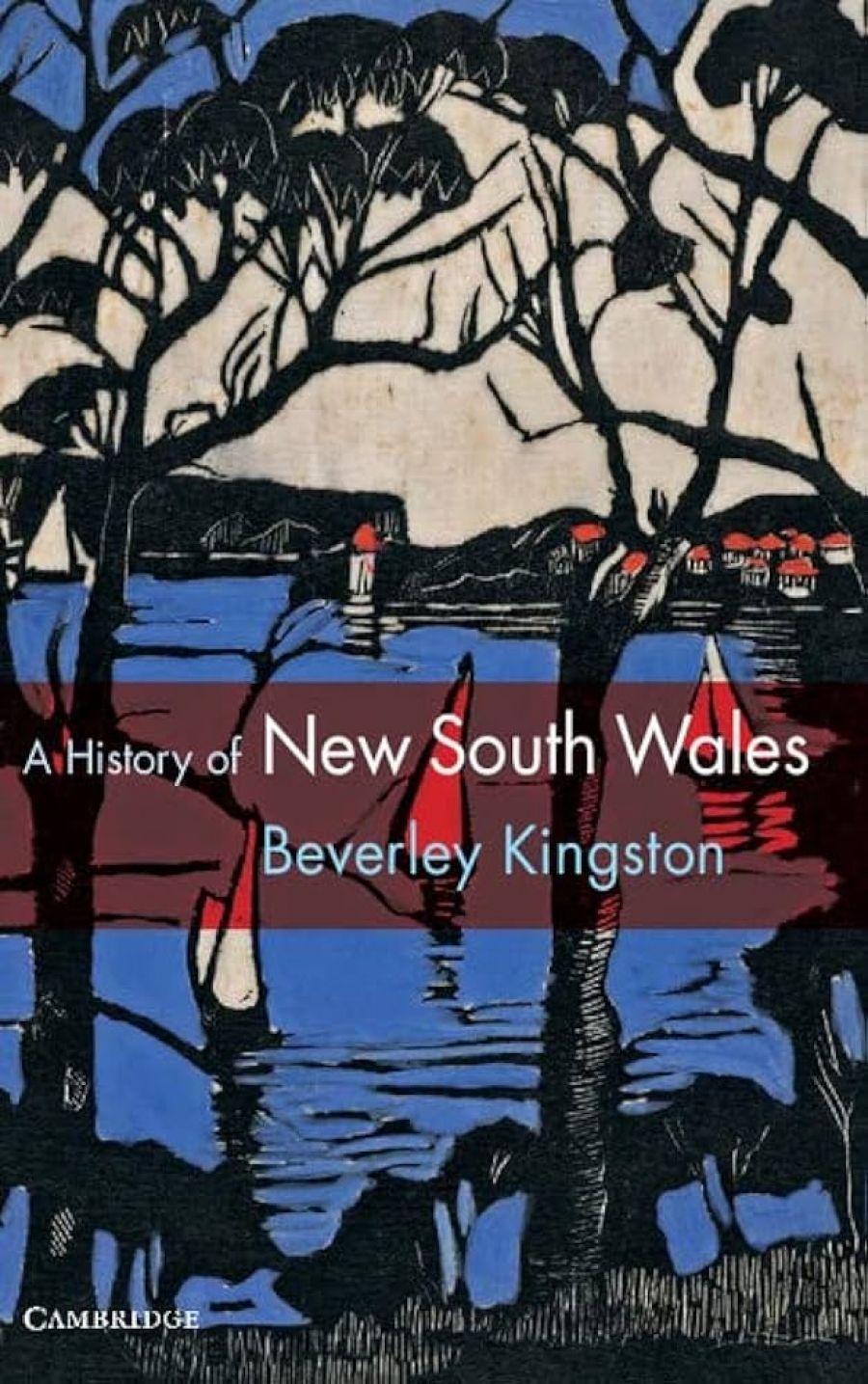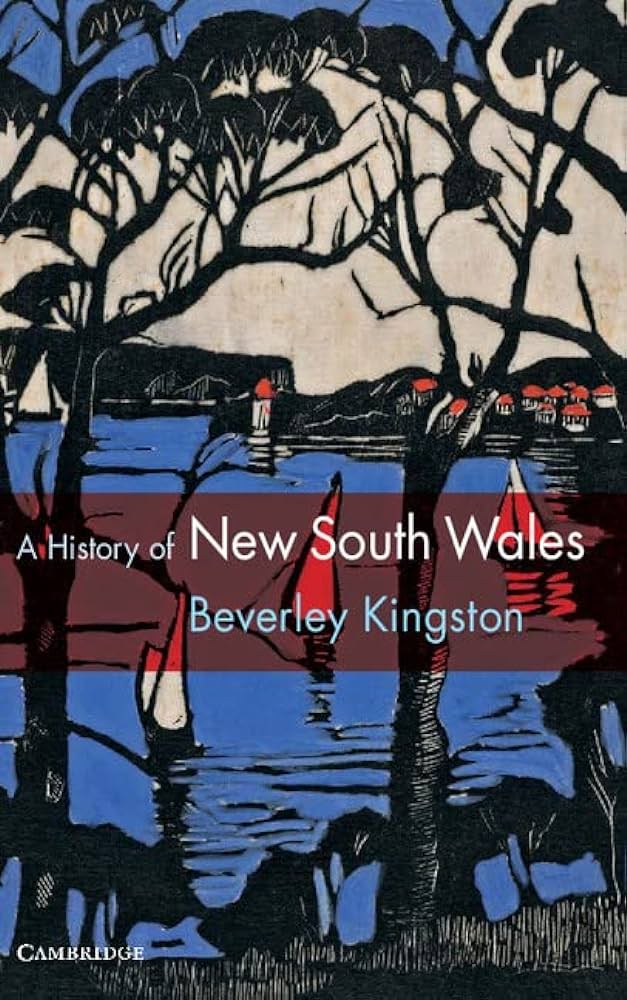
- Free Article: No
- Contents Category: Australian History
- Review Article: Yes
- Article Title: The bits left over?
- Online Only: No
- Custom Highlight Text:
This book has one of the most beautiful covers you could hope to see: a Margaret Preston woodcut of Sydney Harbour, in rich blue, scarlet and ivory. Nor does the inside disgrace the exterior. It is a long time since anyone attempted a history of New South Wales, more than a century according to the blurb, presumably a reference to T.A. Coghlan’s annual publication, The Wealth and Progress of New South Wales, the last edition of which appeared in 1901. Beverley Kingston is highly qualified to do the job, and the twentieth-century detail is especially good.
- Book 1 Title: A History of New South Wales
- Book 1 Biblio: Cambridge University Press, $36.95 pb, 300 pp
- Book 1 Cover Small (400 x 600):

- Book 1 Cover (800 x 1200):

When Coghlan gave up publishing Wealth and Progress, it was probably because Federation led him to larger topics; his more important books henceforth were about Australia as a whole. There is a related explanation for the century-long gap. As Kingston says: ‘While all the other Australian states have managed to maintain a kind of identity [from colonial days], after 1901 New South Wales seemed to be submerged in the federation or to be seen as the Australian archetype.’ It could be said, too, that the State as we now know it consists of the bits remaining to the Sydney government when the newer colonies were gone. How is the history of such an entity to be written? Kingston has clearly wrestled with the problem, and it is an open and interesting question as to whether she quite pulls it off.
It seems to be pure coincidence that this book comes out at the same time as a number of other publications designed to make the sesquicentenary of responsible government in New South Wales. Indeed, historical work on Australian states seems to be burgeoning. All six were to some extent ‘submerged in the federation’, especially with the growth of the federal government after World War II. Do we see now a kind of revival, with even New South Wales asserting a distinctive past and future? Has the neo-conservative centralism of the last twenty years given new life to pre-Federation loyalties?
Despite the shimmering cover, this is not a celebratory book. It is characteristically Kingston, in its pungent mix of cynicism and generous affection, and, as with Glad Confident Morning (1988), her brilliant volume in the Oxford History of Australia, it is particularly strong and engaging in the way it deals with the production of wealth – grazing, mining, sugar-farming, dairying and so on – subjects historians now tend to shy away from. The story of pre-World War I irrigation efforts, leading to the building of Burrinjuck Dam and the establishment of the Murrumbidgee Irrigation Area, is a case in point. But there is no sense whatever of accumulating triumph. Indeed, cynicism seems most obvious in the last stages of the story.
The writing is especially heartfelt in its references to Sydney, with vivid detail of the city between the 1830s and the 1850s, and lucid arguments about the last thirty or forty years. In both cases, we sense the powerfully unique character of a living community. This is clearly a book written in Sydney, and the hinterland remains the hinterland. That vast territory is frequently invoked and fondly described, but the reader gets no strong sense of its size and diversity. In his brief entry on New South Wales in The Oxford Companion to Australian History (1998), John Hirst, with his foreigner’s eye, seems to strike a better balance in this regard.
While the bulk of the detail is invaluable, the overall thrust and purpose of the book is hard to pin down. Glad Confident Morning was about Australia as a whole within a particular period (1860–1900), and in stitching together the circumstances of a single generation, Kingston was undoubtedly at her best. She is less sure in dealing with the long term, and in holding onto thematic threads in a maze of rapidly changing circum-stances. Thus, several of her leading twentieth-century themes are not well prefigured in her account of colonial times. Just as the rural parts of New South Wales are not well interconnected, so the beginnings of the book are only loosely related to the end.
For instance, while there is a good deal of useful demographic material for the twentieth century, there is no reference at all to the vast influx of convicts in the years following 1815, which doubled the population within five years, nor to the flood of assisted free immigrants during 1836–42, which had a similar impact as well as dramatically changing structures of age and gender. Kingston’s description of intellectual life is also much richer for the later period. She gives an excellent account of the influence of John Anderson, of Sydney University; it is central to her description of the cultural ethos of mid- and late-twentieth century New South Wales. But she has nothing equivalent to say about colonial culture. There are perceptive remarks about the impact of the convict system on common habits and attitudes at the time. Thus, ‘The society emerging from this unpromising beginning was callous, hypocritical, legalistic, but good at making the most of anything, whether native grasslands or human weakness.’ And yet, the intellectual dimension of these or any other characteristics of colonial life is ignored. To all appearances, vivid cerebral activity was non-existent in New South Wales before World War I. Kingston tends to make institutions the bedrock of social existence. As a result, by her account complex thinking is the preserve of universities. And again, while the detail on twentieth-century Aboriginal life is probably as full as can be expected in a work this size, there is nothing on the pre-settlement period (except for a map of language groups) and only four brief sentences on frontier violence. This raises another point. Sometimes, Kingston seems to be almost deliberately unfashionable. In the same way, no one would guess, from her unenthusiastic engagement in this book with the lives of women, that she was one of the main pioneers of women’s history in Australia. This latest work also lacks that sense of the inwardness of daily life, of adapting, budgeting and making do, which might have been expected from the author of Basket, Bag and Trolley: A History of Shopping in Australia (1994).
Kingston keeps her most intriguing remarks about the overall sweep of New South Wales history to the end of the book. Take two examples. ‘Of all the Australian states,’ she says, ‘only New South Wales shares with the United States something of the eighteenth-century ethos.’ And yet, there is no hint anywhere as to what ‘the eighteenth-century ethos’ might be. Similarly, a focus on primary industry, she says, had always meant a reliance on a relatively unskilled workforce: ‘So there ceased to be much demand for creativity, versatility or innovation, either in the education system or in society as a whole.’ If only this idea had been explored earlier on.
We might doubt, on finishing this book, whether New South Wales has a history in any connected sense. Sydney certainly does, and so does the colony-state as Sydney’s hinterland. But New South Wales as a jigsaw of equal pieces — and as community interlinked in any way except through its metropolis — is another matter. John Hirst’s piece in the Oxford Companion offers a telling alternative, hinting as it does at a single, cogent narrative. And yet, maybe Kingston’s picture is more accurate. Maybe New South Wales is indeed simply the bits left over. If only in the interests of good government, it is a question that needs more thrashing out.


Comments powered by CComment